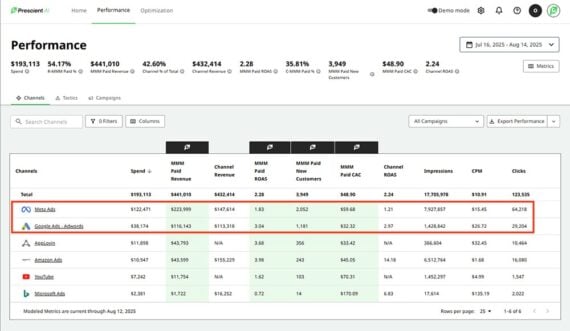Advertising attribution is supposed to identify and assign credit to the actions and campaigns that lead to conversions. One might surmise that the process is simple with digital ads and large language models.
It is not.
Even the best forms of multi-touch attribution (MTA) are inexact owing to privacy regulations, platform changes, and the messy way shoppers move between websites and even physical stores.
Predictive Advantage
Imagine a retailer running Meta ads to drive traffic to its site. Those ads might inspire shoppers to buy later at Amazon. Contemporary attribution never sees those sales, so the ads look unprofitable. The marketing team might cut the campaign, not realizing it boosted revenue elsewhere.
The result is a blind spot. Marketers often undercount investments that create awareness, while lower-funnel ads look like heroes.
Yet MTA is better than last-touch attribution, and last-touch is better than guessing. But the next step toward understanding the impact of ads and marketing may be a form of predictive modeling similar to media mix modeling (MMM), but with channel-level accuracy.
Predictive attribution modeling “will take you at least to the campaign level,” said Cameron Bush, vice president of digital transformation at Meyer, a cookware manufacturer, as he described his experience.
“I have one campaign in Meta right now that I’m looking at in [Prescient AI, an attribution platform], where 100% of its revenue and MMM ROAS is being driven by Shopify,” Bush continued.
“The [campaign] right below it is 50/50 between Shopify and Amazon and has slightly higher ROAS. That’s a level of sophistication that I wouldn’t have had,” said Bush, comparing predictive models to MMM and MTA.

Predictive AI forecasts each campaign’s impact on overall revenue, as illustrated by this example from Prescient AI. Click image to enlarge.
Decision-Making
Predictive modeling approaches the same goal as marketing mix modeling and multitouch attribution.
Instead of piecing together every customer touchpoint, it models the relationships between spend and revenue across channels. Then it simulates outcomes, combining MMM-style aggregate measurement with campaign-level outputs, informing marketers:
- Influence of channels and campaigns on each other and overall revenue.
- Impact of top-of-funnel campaigns on downstream revenue.
- Effect of changes to promotional and marketing spend on profit.
The challenge is what to do with that info.
“We look at Excel spreadsheets. We look at dashboards. We look at all this kind of stuff, and it gives us a really good picture of what is going on today. But it doesn’t tell me what to do,” said Cody Greco, co-founder and chief technology officer at Prescient AI.
The work of answering “what should I do now?” is passed to the marketer to forecast.
“The cool thing about predictive modeling is it actually helps answer the next rational question,” Greco said.
A marketer can ask, say, what happens if she doubles her spend on Instagram, and receive an answer with a high degree of confidence.
Media Buying
Predictive modeling could affect retail media buying in a few ways.
- Branding and content. Understanding how top-of-funnel promotions and content marketing aid advertising conversions may reinvigorate branding.
- Budget clarity. Reallocate investments for the best returns.
- Automation. Placing bids and adjusting spend could, eventually, become automatic.
Contemporary attribution often drags marketing teams into debates over detailed metrics. Predictive modeling reduces those arguments, freeing teams to focus on creative and campaign planning.
Shift in Focus
Hence marketers who delegate the tasks of identifying channels could achieve a renaissance in creativity and content, according to Meyer’s Bush.
To be sure, predictive modeling doesn’t erase uncertainty or replace marketers. Yet if successful, it will change promotions for ecommerce and omnichannel businesses.
Think of it like weather forecasting. Marketers will not explain every raindrop; they will focus on whether you’ll need an umbrella tomorrow.



